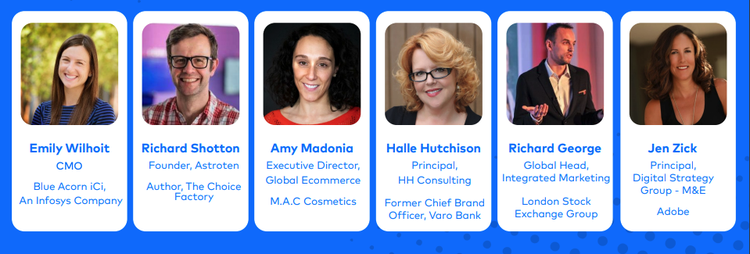[Webinar Recap] Digital Efficiency vs. Customer Experience

Did you miss the recent Blue Acorn iCi and Adobe virtual event covering Digital Efficiency vs. Customer Experience? Not to worry, we’ve provided a recap from industry experts on how brands can strike the perfect balance between immersive and efficient customer experiences.
Parts of the Customer Experience That Matter the Most
Some moments matter more than others. Instead of trying to make the experience equal all around, expect some weaknesses and create one or two stand-out occasions that will be remembered.
The two moments to focus on are the peak of the experience and how it ends. Customers will remember how they felt when it’s all said and done, and because of this, it’s more important for brands to end on a high note rather than relying on first impressions.
Teams should also be aware of friction. Typically, people underestimate friction and instead should focus on reducing the barriers to purchase.
“Organizations put too much time, effort, and money into motivating people to want to buy the product and too little into making buying that product easy. If you can recalibrate their efforts, you’ll be tapping into the most important behavioral science biases there is,” explained Richard Shotton, Founder of Astroten, a consultancy that applies findings from behavioural science to improve marketing.
Is Friction Bad, or Should There Be More?
Friction during the customer journey isn’t always seen as a bad thing. In many cases, the added touch points were what customers wanted, and in the end, they added value and benefited the brand.
When talking about friction, focus on what the customer is feeling versus the hurdles in the process. Changing the terminology to a feeling or emotion is one way brands can tackle that part of the customer experience.
For high-end brands or those wanting to change appreciation levels, carefully add friction in. This barrier leads to higher value purchases. “Just knowing what stage to put that surprise and delight and what stage to leave it out is really key,” stated Halle Hutchison, Principal of HH Consulting.
For example, Sanpellegrino’s cans have built in friction with the foil covering the top of the container. This extra step before enjoying the beverage adds a high-end feel to the overall experience.
To enhance the user experience, here are some reasons to create more barriers to the process:
- It can lead to lifts in average order value
- This increases interaction with the brand and leads to more discovery
Using and Understanding Customer Data
Think like a customer and tap into the ability to switch the lens and look at things more holistically. Under the why behind user intentions and focus on quantitative and qualitative data.
Customers and fans of a brand are willing to provide their preferences.
“Even if you do cheaper research or do it in a more scrappy way, as long as you get a quantitative and qualitative read from a consumer, it always pays back over and over again,” said Amy Madonia, Executive Director, Global Ecommerce of M.A.C. Cosmetics.
As an example, look into changing email communications based on a customer’s location. Someone 5 miles away might respond differently than another who is 40 miles away.
Richard George, Global Head of Integrated Marketing at London Stock Exchange Group, reminds attendees about the importance of storing data in a centralized area and understanding who you can and can’t engage with in an account. “You have to be careful with this. If you get this stuff wrong, it can absolutely have significant consequences for your business,” George explains.
Prediction: Evolving Trends to Watch in the Next 18 Months
We asked the speakers what trends to keep an eye out for in the coming months and how these features will impact someone’s experience.
Building Community: It’s time for brands to think about how they can grow culturally. If consumers know there’s a community using your product, that will only grow with time. Building community isn’t easy, and that’s why many have not been able to implement it.
Virtual Reality: Technology is fueling the potential for augmented reality and higher-end experiences. Companies should think about how they can apply VR to simple marketing campaigns, use it to bring data to life, and to create more visual pieces. This will also be important when considering how to reach and acquire younger generations.
“There’s a lot of experimentation in terms of what the experience can be, especially from an at-home perspective,” Jen Zick, Adobe’s Principal, Digital Strategy Group – Media, Entertainment & Communications told attendees. “Trying to mimic that live experience for the at home fans, because the reality is that the majority of fans won’t make it to a live event. Technology is definitely fueling the potential for augmented and heighted experiences.”
Voice: In the future, anticipate voice becoming a seamless part of everyday life. This technology might not fully advance within the 18-month timeframe, but when it does, it will have implications that are far-reaching for commerce and how we live and operate.
The strategies discussed during this webinar can be used to create a more efficient and immersive experience. If you want to improve the online customer journey, learn how Blue Acorn iCi can help. Contact us today.